A beautifully decorated evergreen tree with colored lights ablaze inspires in many warm memories of Christmases long past. The Christmas tree has become one of the most beloved and well known holiday symbols. For this season, Sunburst has composed an article that talks about Christmas trees past, present and future.
Christmas Tree – Past
Christmas trees are an important specialty crop. Each year approximately 33 to 36 million Christmas trees are produced in North America. In the United States, there are an estimated 15,000 growers, which includes 5,000 choose and cut farms. A number of tree species are grown as Christmas trees. However, because of their superior postharvest needle and moisture retention characteristics, demand for Fraser and noble fir Christmas trees has increased rapidly.
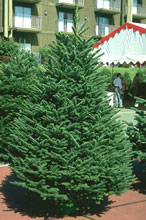 Noble fir Christmas tree
Noble fir Christmas tree
 Fraser fir Christmas tree
Fraser fir Christmas tree
Among the earliest documented decorated Christmas trees in North America are a decorated and illuminated Christmas tree that was set up in a German commander’s home to the north of Montreal, Canada in 1781, and a tree that was displayed at Fort Dearborn, Michigan in 1804.

Harvesting Douglas fir trees from natural stands during the early 1940s near Shelton, WA. Courtesy of the Pacific Northwest Christmas Tree Association
Christmas Tree – Present
Nationally, Oregon ranks first in Christmas tree production, producing about 9 million trees per year, followed by North Carolina at 7.5 million trees. Washington is tied with Michigan for third, with each producing about 4 million trees per year. With improvements in transportation, Christmas trees are commonly shipped throughout the United States, and are also exported to Japan, China, Hong Kong, Philippines, Canada, Mexico, Guam, Puerto Rico, and Samoa.
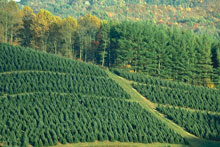 Fraser fir plantation in North Carolina
Fraser fir plantation in North Carolina
Noble and Fraser fir trees are generally considered to have the best postharvest quality of any Christmas tree available today. This species grows naturally in the Cascade Mountains and isolated locations within the Oregon Coast Range. Noble fir is found naturally at elevations ranging from 610 to 1,220 meters (2,000 to 5,000 feet) above sea level, and can be successfully grown within the western portions of the Pacific Northwest.
Fraser fir is closely related to balsam fir, and is native to high elevations in the Appalachian Mountains of North Carolina. Most of the plantations that produce Fraser fir in North Carolina are located at elevations below 1,200 meters (4,000 feet), and thus outside native stands.
Typically, production of noble and Fraser fir Christmas trees requires a total of 12 to15 years. Seed are sown in seedbeds, and seedlings are grown for 2 years. The resulting seedlings are transplanted to ‘line out’ nursery beds for one to three additional years. After 3 to 5 years, trees are large enough to be transplanted to plantations, where they grow into a 6- to 7-foot tall Christmas tree in about 6 to 9 years.
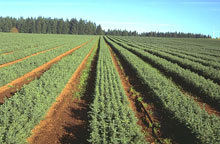 Production of noble fir seedlings
Production of noble fir seedlings
Insect and Disease Problems
With the increasing expansion of noble and Fraser fir plantings, growers are facing a number of insect and disease problems. Balsam twig aphid (Mindarus abietinus), balsam woolly adelgid (Adelges piceae), and the spruce spider mite (Oligonychus ununguis) cause unsightly needle discoloration and/or branch distortion and dieback. When populations are very high, balsam woolly adelgids can also kill Fraser fir trees.
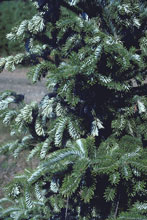 Twisting of newly developing Fraser fir shoots caused by balsam twig aphids
Twisting of newly developing Fraser fir shoots caused by balsam twig aphids
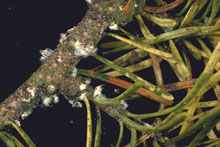 Balsam woolly adelgids on Fraser fir
Balsam woolly adelgids on Fraser fir
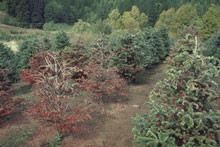 Damage to Fraser fir caused by balsam woolly adelgids.
Damage to Fraser fir caused by balsam woolly adelgids.
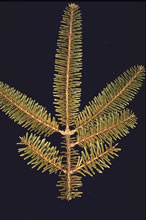 Severe spruce spider mite damage
Severe spruce spider mite damage
The three major diseases that currently limit the production and marketability of noble and Fraser fir Christmas trees are Phytophthora root rot and stem canker, current season needle necrosis (CSNN), and interior needle blight.
Phytophthora Root Rot and Stem Canker
Root rot, caused by Phytophthora cinnamomi, and to a lesser extent, P. drechsleri and P. citricola, is a serious problem on Fraser fir in nurseries and Christmas tree plantations in Western North Carolina. Recent work in North Carolina indicates that average industry-wide losses from Phytophthora root rot are about 9% of the production in a given field, or about $9 million based on a $100 million industry. Phytophthora citricola causes root rot of white fir (A. concolor) and red fir (A. magnifica) in California.
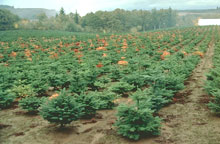 Mortality of trees in a poorly drained area of field caused by Phytophthora root rot
Mortality of trees in a poorly drained area of field caused by Phytophthora root rot
Feeder roots of Fraser fir are initially infected by zoospores of Phytophthora spp. Roots typically will develop a reddish-brown discoloration of the cambium region, which particularly on noble fir may extend up the stem as the pathogen colonizes the root system. As large roots are killed, above ground symptoms associated with Phytophthora root rot and stem canker develop, including chlorosis of foliage, wilting of new growth, branch flagging, stunting, and death of the tree. Needles on branches and trees killed by Phytophthora root rot have a distinctive reddish-brown appearance. In some cases, Phytophthora species also cause shoot blight.
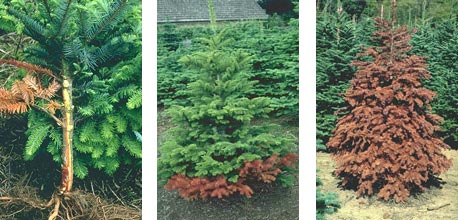 Phytophthora caused stem canker extending up to the entire tree resulting in the death of this noble fir.
Phytophthora caused stem canker extending up to the entire tree resulting in the death of this noble fir.
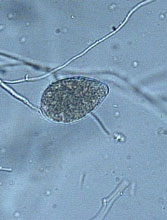 Phytophthora cinnamomi sporangium under the microscope.
Phytophthora cinnamomi sporangium under the microscope.
The use of healthy transplant seedlings and appropriate site selection are the most important factors affecting the management of Phytophthora root rot and stem canker in plantations. Highly susceptible firs should not be planted on sites with heavy, poorly drained soils. Avoiding the use of overhead irrigation, particularly if the water is contaminated with Phytophthora inoculum, will prevent shoot blight. Soil fumigation is seldom used in Christmas tree plantations. Applications of selective fungicides have not generally been effective in controlling this disease on noble or Fraser fir.
Current Season Needle Necrosis
Current season needle necrosis (CSNN) is a poorly understood physiological disorder that occurs on noble and grand fir. Symptoms consist of tan discolored bands. Damaged portions of needles turn reddish-brown in color by mid-summer.
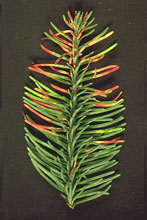 Symptoms of CSNN during late summer
Symptoms of CSNN during late summer
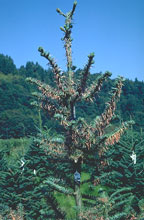 High incidence of CSNN damaged needles in the top of a tree
High incidence of CSNN damaged needles in the top of a tree
Studies are currently underway to examine the possibility of reducing the severity of this disease with foliar applications of other types of calcium-based materials, as well as a plant growth hormone called Conicur, which contains 2-hydroxypropanoic acid.
Interior Needle Blight Syndrome
Interior needle blight is the most important needle cast disease of noble fir Christmas trees. Although several fungi are associated with diseased needles, an undescribed species of a Mycosphaerella-like fungus is most commonly found on diseased needles. Symptoms consist of random browning of older needles, mostly on lower branches. Eventually, all of the needles except the current season’s growth can be damaged. Observations suggest that Fraser fir are resistant to this disease.
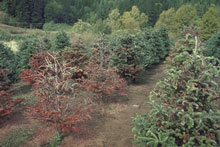 Interior needle blight symptoms on a severely diseased noble fir
Interior needle blight symptoms on a severely diseased noble fir
Christmas Tree – Future
Since the use of Christmas trees plays such an important role in the cultures of many people, demand will remain strong for species of Christmas trees like noble and Fraser fir that have excellent needle and moisture retention characteristics. Phytophthora root rot, CSNN, and interior needle blight are currently limiting the ability to meet the demand for these trees. Emphasis on production of healthy transplants coupled with careful site selection will help growers limit the damage caused by some of these diseases.
The future looks promising, with many growers utilizing innovative approaches such as grafting noble and Fraser fir to rootstocks that are resistant to Phytophthora root rot. Long-term solutions to Phytophthora root rot and CSNN will no doubt come through breeding programs for disease resistance such as those that are underway in North Carolina and the Pacific Northwest.
Source of the article
Gary A Chastagner and D. Michael Benson. Plant Health Progress – Plant Health Reviews – 13 October 2000

